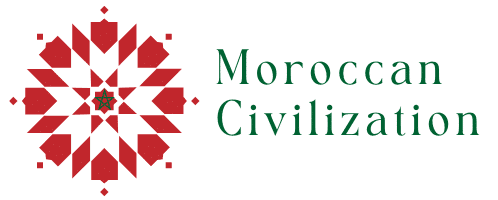My Stay Ait Ben Haddou: Kasbah Life, Tea, and Sunset
I didn’t come to Ait Ben Haddou as a blogger, guide, or filmmaker. I came as a Moroccan looking for truth behind the myth. Driving the Road of a thousand Kasbahs from the Dades Valley felt like paging through Morocco’s memory.
Table of Contents
Every bend revealed a fortress of mud and straw, weathered but still standing proof that we don’t need skyscrapers to tell epic stories. This land whispers, and if you listen closely enough, it sings in Amazigh and Arabic both.
Instead of staying in a predictable guesthouse in Ouarzazate, I chose a real kasbah on the outskirts of the old ksar. That changed everything. My room apartment nine opened onto a view that caught the sunset like it had practiced for centuries. Clay walls, wooden beams, no TV, no distractions. Just stillness and scent: thyme, dust, and wood smoke. The way it used to be before noise became normal.
Michel and Colette my hosts had come here with nothing in 2002. No electricity. No roads. Just belief. They built their home and lives slowly, brick by handmade brick. That night, under soft jazz and Berber tapestries, they served turkey tagine so rich it felt like a holiday. This wasn’t some commercialized tourist spot it was real.
The Ksar That Holds Its Own Against Cameras
Crossing the dry bed of the Ounila River at dawn, I reached the eastern gate of Ait Ben Haddou. Before the bridge was built in 2011, locals crossed here on donkeys when the waters ran high. Now, travelers stroll in unaware of the layers beneath their feet.
Inside the ksar, life moves in still frames. A woman hand-weaving wool in the shadows. A child selling postcards beneath a fig tree. Then there’s the square you know the one where Gladiator filmed Maximus’s first battle. Yes, Game of Thrones filmed here too. Slaver’s Bay, Season 3. But it’s not a set. It’s a survivor.
You want movie magic? Sure. But if you pause long enough, you’ll find something deeper. Something older than cinema like what I felt in Kasbah Tamnougalt or among the 7 Real Experiences that show Morocco’s true soul. Ait Ben Haddou isn’t pretending to be anything. It simply is.
The Architecture of Survival
What Makes a Ksar? Clay, Wind, and Time
At Ait Ben Haddou, everything breathes. The walls, the earth, even the silence. This isn’t some postcard kasbah for tourists. It’s a ksar, a fortified village, where families once lived side by side, building their homes from the ground they stood on. Clay, straw, and sun. That’s it. No steel, no concrete. Just knowledge passed from generation to generation, shaped by the desert.
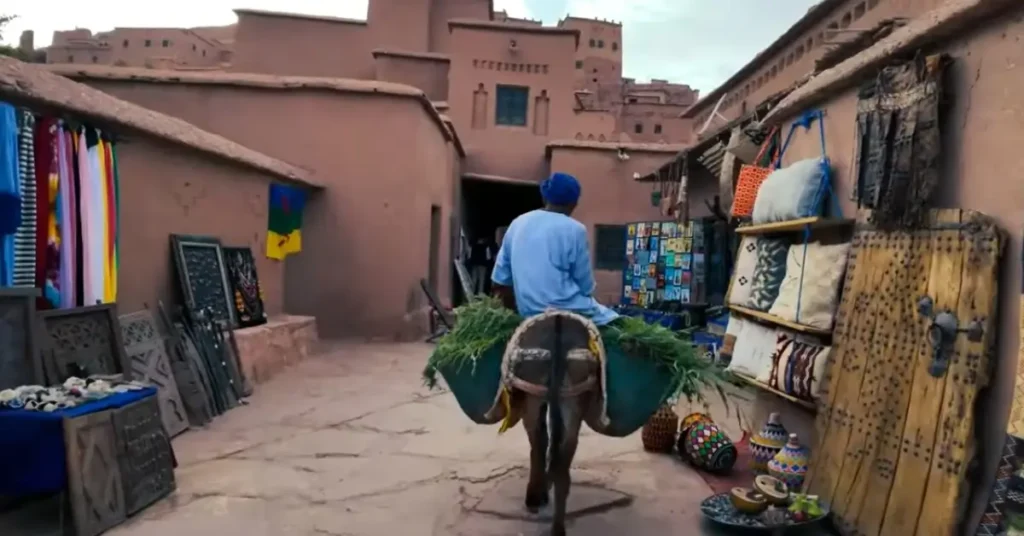
The beauty here isn’t just in what you see. It’s in what you feel. Cool air in the narrow alleys on a hot day. The weight of centuries pressing gently through the walls. And that name Ait Ben Haddou it matters. “Ait” in Amazigh means “the people of.” These are the people of Haddou’s son, a lineage rooted in the earth. Not for tourists. Not for cameras. But for community, safety, and survival.
Building with Baraka: Why It Lasted
I’ve walked through old riads in Fez, explored crumbling corners of the Rif, but here, something holds. Maybe it’s the dryness. Maybe it’s the care. Maybe it’s baraka that blessed energy you can’t touch, only feel. In Ait Ben Haddou, nothing is wasted. Every doorway lines up with a purpose. Every roof serves more than one use. Shade, storage, shelter.
Up at the granary, the view stretches across the valley like time itself. It’s easy to imagine watchmen standing there, scanning for caravans or danger. That feeling that stillness and strength you can’t fake it.
When I stood there, I thought of the timeless places from the Best Morocco Tours Itineraries or the intimacy we share with travelers on our Morocco Small Group Tours. This isn’t just architecture. It’s a way of living with the land, not over it.
Between Locals and Legends
Most people think Ait Ben Haddou is a museum or a set left behind by a film crew. And to be fair, it looks like one. But the truth is, a handful of families still live within the ksar’s thick walls. They’re few now. Maybe four or five homes are still occupied inside the original structure. Most others moved across the river after modern housing and electricity arrived. Life is just easier there. Still, those who stay in the old ksar choose it for a reason.
Do People Still Live in Ait Ben Haddou?
When I walked through the narrow alleys early in the morning, I saw a man pouring tea outside his doorway. I greeted him, and we talked for a while. He was born there. He had offers to leave. But he said the silence, the view, the light at dusk, they keep him anchored. That kind of quiet doesn’t exist in cities. It barely exists anywhere now.
The Women’s Carpet Cooperative: Real Change
One of the most powerful moments of my visit came not in a film location or lookout point, but inside a small carpet shop just past the eastern entrance. This was no tourist showroom. It was part of a women’s cooperative made up of more than two hundred artisans, most working from home in nearby villages.
Eighty-five percent of the profit goes directly to these women. That means schoolbooks, food, repairs, independence. I saw hands dyed red from henna and rough from the loom, hands weaving patterns older than any film script. These are the real stories of Ait Ben Haddou. The kind that don’t fade with time.
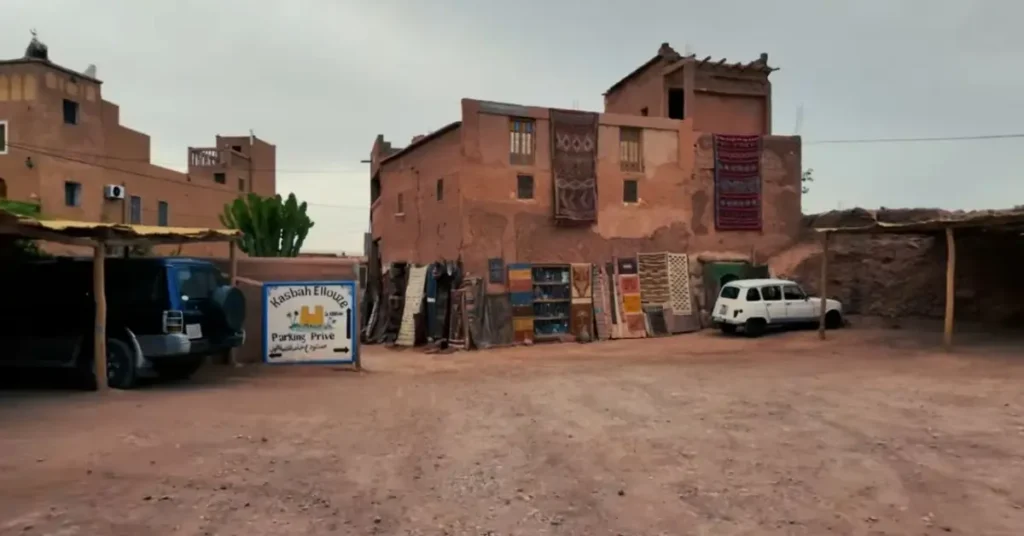
In our Morocco Travel Group Adventures and Morocco Adventure journeys, I’ve seen travelers moved to tears by the authenticity of these cooperatives. They remind us that heritage isn’t something to photograph. It’s something to support and protect.
Film, Fantasy, and Reality
Ait Ben Haddou has seen more cameras than any other ksar in Morocco. It has starred in legendary films like Gladiator, The Mummy, Kingdom of Heaven, and Babel. Even Game of Thrones came here. If you’ve seen the city of Yunkai in Season 3, you’ve already seen Ait Ben Haddou. That main square where Maximus fought in Gladiator? It’s right there, quiet now, waiting for the next traveler to wander through.
The beauty of this place is that it doesn’t need Hollywood to make it magical. The film crews come for a reason. They barely have to change anything. The mudbrick walls, the winding alleys, the towers on the hilltop are already cinematic. But what many visitors forget is that the ksar existed long before the cameras arrived. Its value is not in how it looks on screen, but in what it means to those who live nearby.
From Gladiators to Dragons: Ait Ben Haddou On-Screen
Some locals benefit from the industry. Directors pay to use homes as sets. Extras are hired for background roles. But tourism shaped by film fame can also turn this place into a stage. That’s why it matters how we visit. If you move slowly, speak softly, and really observe, you’ll find Ait Ben Haddou is not just a location. It’s a living memory.
Is Ait Ben Haddou Worth It or Overhyped?
People ask me all the time. Is it worth going? Isn’t it just a tourist trap now? The answer depends on how you travel. If you only come for a photo, you’ll leave with a photo. But if you stay a night, cross the river on foot, and climb to the granary at sunset, it stays with you. That feeling is real.
We always include Ait Ben Haddou in our Morocco Travel Tours in 2025 because it opens something in people. The light, the silence, the wind brushing over old walls. It doesn’t perform. It just exists. That’s the power.
And when the trip continues, many of our guests pair this visit with our Explore Best Marrakech Morocco Tours. It helps them understand how the desert and the city mirror each other. One is stillness. The other is rhythm. You need both to understand Morocco.
So yes, Ait Ben Haddou is worth it. But only if you let it slow you down.
How to Visit Respectfully
Ait Ben Haddou isn’t something you just check off a list. You don’t come here just to say you did. If all you do is snap a quick photo from the road, you’ll leave with nothing more than a blur. But give it your time, even a few hours, and the place begins to speak. Stay the night, and it starts to sing.
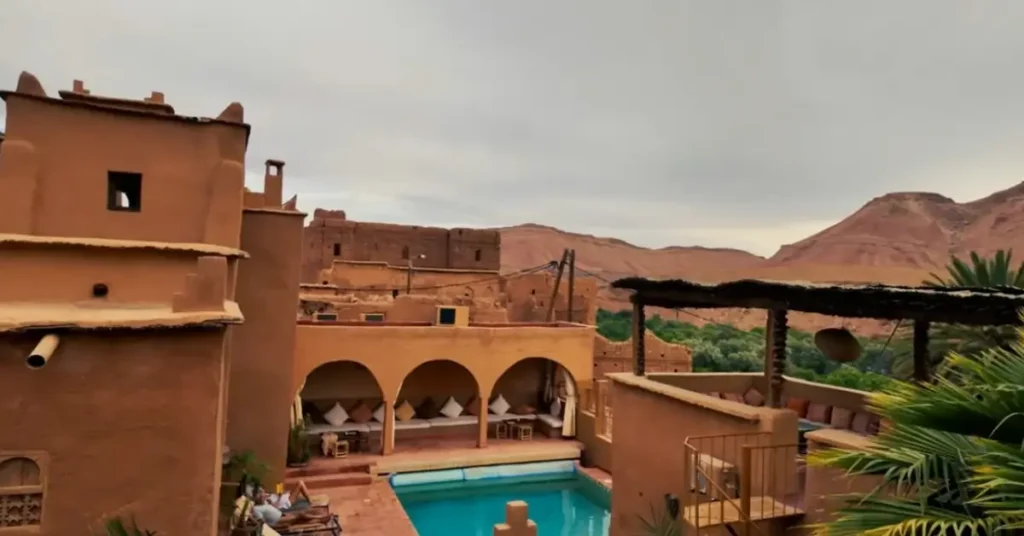
How much time do you really need?
Early mornings are golden. The light pours over the clay walls softly, before the tour buses show up. In those quiet minutes, you can walk through empty paths, hear your own footsteps, maybe catch the sound of a rooster from the modern village across the river. Then in the late afternoon, the colors shift again. The ksar glows. And at sunset, if you climb to the granary at the top, you’ll find a view so vast it pulls the words right out of you.
Most people rush in from Marrakech on a long day trip and barely touch the surface. But if you’re building a journey with intention, I always recommend slowing down. Add Ait Ben Haddou into a loop like the ones we offer in Morocco Tours 2025. Or take your time with the longer circuits inside our Morocco Tour Packages. These aren’t just routes. They’re invitations to breathe, connect, and feel something real.
Is Ait Ben Haddou safe, and how do you get there?
Yes, it’s safe. The rhythm of the place is calm, and people are welcoming. Like everywhere in Morocco, kindness and respect open doors. Dress with modesty, speak with warmth, and if someone shares their craft or story with you, give back. Buy a small weaving. Sit and listen. It all matters.
If you’re coming from Ouarzazate, it’s a simple thirty-kilometer trip. A grand taxi will cost around 150 to 200 dirhams. There are also shared taxis to the nearby village of Tabouraht, then it’s just a short walk in. For drivers, the road from Marrakech crosses the Tizi n’Tichka Pass — long, winding, but breathtaking.
There’s no complicated trick to visiting Ait Ben Haddou. What’s rare is finding a place that still feels this alive, this quiet, this true. And once you’re there, the silence teaches you how to listen.
The Wind at Sunset
From the granary tower, time stands still
The climb isn’t long, but it feels meaningful. Step by step, the view widens. The clay underfoot gives way to sky, and suddenly the whole valley unfolds around you. Standing at the top of the granary in Ait Ben Haddou, I understood why this place was built here. It wasn’t just for defense. It was about vision. The ability to see what’s coming. The ability to endure.
By that hour, most of the visitors were gone. The heat had softened. The wind picked up, brushing past the old walls like an old friend returning home. From up there, the village below seemed untouched by time. The riverbed, dry but familiar. The palms, still green. And the ksar itself, glowing in the last light of day.
There were no guards. No tour guides. No signs. Just the sky above, the stories beneath, and the silence of something that refuses to vanish.
Memory over movie magic
People often ask why Ait Ben Haddou matters. Is it the history? The architecture? The movie credits? All of that plays a role. But the truth is, what stays with you is none of those things.
It’s the feeling of walking through a place built by hands that believed in something lasting. It’s the simplicity of a clay wall still standing after centuries of wind. It’s the woman weaving under a fig tree. The child running barefoot over the earth. The taste of tea that hasn’t changed in generations.
Hollywood didn’t make this place matter. It only gave the world a glimpse. The real beauty of Ait Ben Haddou is that it survives without the spotlight. It doesn’t ask to be noticed. It simply is.
And maybe that’s why it stays with you. Long after you’ve left, long after the dust has washed off your shoes, the memory lingers.
If your next stop is the city, take that quiet with you. Whether you end your journey with a walk through the red alleys of Marrakech or begin a new adventure like the one mapped out in our Morocco Trip, let this place anchor you. And if you want more stories like this, the blog is always open.
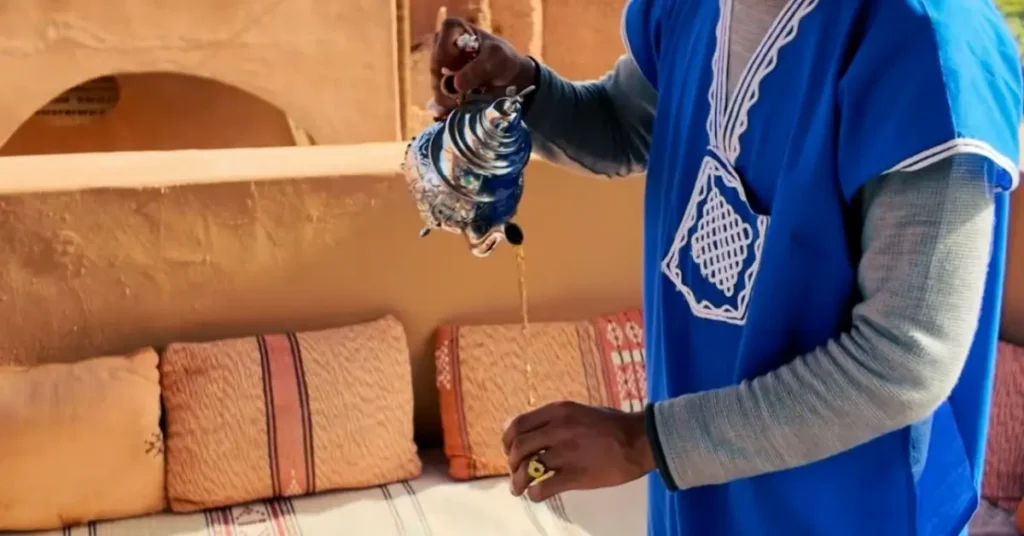
What Ait Ben Haddou taught me is simple. Stillness has its own kind of power. And the past is never really gone. It’s just waiting for someone to slow down and listen.
